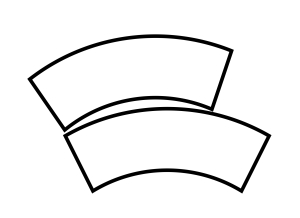एतयैव सविचारा निर्विचारा च सूक्ष्मविषया व्याख्याता॥४४॥
etayaiva = by this alone; savichaaraa = samadhi involving reflection; nirvichaaraa = samadhi not involving ‘vichara’; cha = and; sUkShmaviShayaa = involving subtle objects; vyaakhyaataa = is described or explained
Aranya
"By this (foregoing) the Savichara and Nirvichara engrossments, whose objects are subtle, are also explained"
When the concentration on the subtle elements is conditioned by time, space and causation, it is called "savichara" samapatti. When the concentration is not affected by any mutation due to time or space, it is called "nirvichara". When there is any verbal reflection on the object, it becomes "savichara".
In "savichara" samadhi, the reflection is on the object as a complete unit. However, it involves the use of ‘memory’ for its reflection. In "nirvichara", the memory element is completely absent. Only the illumination of the subtle element, dissociated from any reflective thought, but associated with the latent impression of this type of samapatti only, is present in the mind.
Taimni
"By this (what has been said in the two previous sutras) Samadhis of Savichara, Nirvichara and subtler stages (1-17) have also been explained"
In this sutra Patanjali simply states that the mental processes in ‘savichara, nirvichara’ and higher states of samadhi are identical to those found in the ‘savitarka, nirvitarka’ samadhi. As we learned in sutra 1.17, ‘savichara’ involves concentration on subtle objects. The process of perceiving material objects is done through the faculty of the five senses. But at higher spiritual planes, perception takes place through a single entity called ‘pratibha’ which performs the functions of all five sense-organs. These higher faculties can overcome the limitations of the intellect in getting to know an object in its true reality.
Samapatti Examples
Savitarka: take the sun as the gross object of contemplation. Even though the mind has the sun alone as the object, its characteristics like "it is round", "it is far away", "it is very bright" etc. are also cognized.
Nirvitarka: While concentrating on the sun, only its luminosity will be realized, shutting out all other characteristics. The mind becomes unaware even of itself, e.g. "I am meditating on the sun". In this type of contemplation, the yogi sees all gross objects purely as a combination of sense elements – light, touch, taste etc. This may lead to the yogi achieving the state of ‘vairagya’ (detachment).
Savichara: While contemplating on the sun, the yogi calms the mind and the senses and focuses on the light "tanmatra" – the subtle sense element related to sight. In this case, the samadhi is conditioned by words, objects and their knowledge and affected by time, space and causation. Also, all pleasure and pain etc associated with such objects disappears. Other subtle elements like the ego, intellect and the pure I-sense can also be used as objects of meditation.
Nirvichara: In this case, the mind is full only of the object without any association with verbal concepts and without an idea of time and space.
Discussion
In Savitarka samadhi, our perception is colored by our memory as well as space-time limitations. Some of the famous visual illusions can be used to illustrate some of these concepts. In the picture above, the two parallel lines are the same length; however, the upper line appears to be shorter than the other one. In Savitarka, even though our mind is completely filled with this image, but due to awareness of space and other objects surrounding the horizontal line, we misjudge the actual length of the lines. A similar example is depicted in the second picture below.
When we migrate to Nirvitarka samadhi, we are able to focus entirely on the horizontal lines without any interference from the other lines. That way, we are able to know that they are the same length.
During our discussion, we came upon a few other expressions which are used in modern literature on psychology and have a meaning quite similar to Samadhi.
Gestalt
Gestalt is a German word and has the following connotation:
"A physical, biological, psychological, or symbolic configuration or pattern of elements so unified as a whole that its properties cannot be derived from a simple summation of its parts. "
"Essence or shape of an entity’s complete form"
"The whole is greater than the sum of the parts"
Grok
The word "grok" was used in the book "stranger in a strange land" by Robert A. Heinlein. Its meaning is almost identical with the concept of "nirvitarka" or "nirvichara" samadhi as described in the sturas above.
"Grok means to understand so thoroughly that the observer becomes a part of the observed—to merge, blend, intermarry, lose identity in group experience. It means almost everything that we mean by religion, philosophy, and science "


Leave a Reply